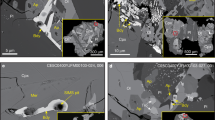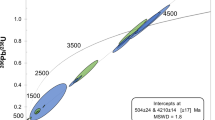Abstract
FOR the proper interpretation of radiometric rock ages it is important to know which processes are able to reset radioactive clocks. In particular, the resetting by intense shock effects is significant in lunar chronology because most lunar highland rocks are impact breccias produced in the course of multiple large meteorite impacts. For the important K–Ar scheme, we have dated variously shocked samples from ejecta and from a drill core through one of the best documented terrestrial meteorite craters the Nördlinger Ries (Southern Germany)1. From K–Ar and fission track dating of thoroughly melted impact glasses the 24 km diameter Ries crater was found to have formed 14.7±0.7 Myrago by meteorite impact into the variscian bedrock (for summary of ages see ref. 2). The modern version of K–Ar dating (39Ar–40Ar technique) can reveal quantitative information about partial losses of radiogenic argon (fractional resetting) in addition to yielding ages eventually not affected by these gas losses3,4. We have applied this dating technique to mineral separates (hornblende, biotite, chlorite) from ejecta, fall-back breccias and underlying bedrock of the Ries Crater, including drill core samples taken at depths up to 1,201 m(ref. l).The samples exhibit various degrees of mechanical strain (from ∼ 10 kbar up to >400 kbar shock pressure). Apart from the thoroughly molten glasses which reproduced the impact age of ∼ 14.7 Myr, we found that all other rocks involved in the impact irrespective of the degree of shock metamorphism and within the limits of error, yield the same 39Ar–4oAr age of 313±3 Myr, probably the age of the bedrock. Apparently, rocks exposed to the very intense shock effects frequent on the Moon give reliable K–Ar ages when measured as K–Ar plateau ages. Age resetting, if present, probably results from heating associated with such impacts. In the case of the Ries, we found from the diffusion characteristics of argon that the post-shock temperature of the crystalline fragments within the suevite layer has not exceeded 600 °C.
This is a preview of subscription content, access via your institution
Access options
Subscribe to this journal
Receive 51 print issues and online access
$199.00 per year
only $3.90 per issue
Buy this article
- Purchase on Springer Link
- Instant access to full article PDF
Prices may be subject to local taxes which are calculated during checkout
Similar content being viewed by others
References
Geologica bav. 75, 1–470 (1977).
Gentner, W. & Wagner, G. A. Geologica bav. 61, 296–303 (1969).
Merrihue, C. M. & Turner, G. J. geophys. Res. 71, 2852–2857 (1966).
Kirsten, T. in The Origin of the Solar System (ed. Dermott, S. F.) (in the press).
Engelhardt, W. von & Graup, G. Geologica bav. 75, 255–271 (1977).
Engelhardt, W. von, Stöffler, D. & Schneider, W. Geologica bav. 61, 229–296 (1969).
Chao, E. C. T. Neues Jb. Miner Abh. 108, 209–246 (1968).
Jessberger, E. K., Kirsten, T. & Staudacher, Th. Proc. Lunar Sci. Conf. 7 2201–2215 (1976).
Jaeger, E. Colloquium on the Geochronology of Phanerozoic Orogenic Belts, Zurich and Bern (1969).
Chao, E. C. T. Geologica bav. 75, 421–441 (1977).
Davis, P. K. Geochim. cosmochim. Acta 41, 199–206 (1977).
Wolfe, S. H. J. geophys. Res. 76, 5424–5436 (1971).
Hartung, J. B., Dence, M. R. & Adams, J. A. S. J. geophys. Res. 76, 5437–5448 (1971).
Jessberger, E. K. et al. Conf. Comp. Mercury, Moon, Lunar Sci. Inst., Contr. 262, Houston, Texas (1976).
Wagner, G. A. Geologica bav. 75, 349–354 (1977).
Author information
Authors and Affiliations
Rights and permissions
About this article
Cite this article
JESSBERGER, E., STAUDACHER, T., DOMINIK, B. et al. Limited response of the K–Ar system to the Nordlinger Ries giant meteorite impact. Nature 271, 338–339 (1978). https://doi.org/10.1038/271338a0
Received:
Accepted:
Published:
Issue Date:
DOI: https://doi.org/10.1038/271338a0
This article is cited by
-
40Ar-39Ar ages of scandinavian impact structures: I Mien and Siljan
Contributions to Mineralogy and Petrology (1978)
Comments
By submitting a comment you agree to abide by our Terms and Community Guidelines. If you find something abusive or that does not comply with our terms or guidelines please flag it as inappropriate.



